![]()
![]()
![]()
Use LEFT and RIGHT arrow keys to navigate between flashcards;
Use UP and DOWN arrow keys to flip the card;
H to show hint;
A reads text to speech;
77 Cards in this Set
- Front
- Back
|
volts
|

unit of measure for the difference of potential in a given circuit
|
|
|
Amperes (amps)
|

Is a measure of the amount of electrical charge passing a point in an electric circuit unit of time with 6.241x10^18 electrons, or one coulomb per sec. constituting one ampere
|
|
|
ohms
|

The unit of measure for resistance in a electrical circuits
|
|
|
direct current (D/C)
|
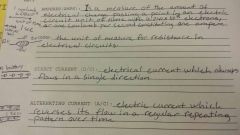
electrical current which always flows in a single direction
|
|
|
alternating current (A/C)
|

electric current which reverses it's flow in a regular repeating pattern over time
|
|
|
frequency
|

The rate at which any process repeats its self or the number of repetitions of something in a given period of time
|
|
|
coupling
|
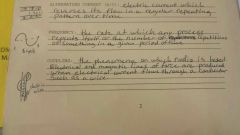
The phenomenon on which radio is based. electrical and magnetic lines of force are produced when electrical current flows through a conductor such as a wire
|
|
|
The purpose of equipment grounds?
|
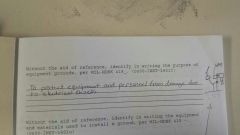
to protect equipment and personnel from damage due to electrical shock
|
|
|
The equipment and materials used to install a ground?
|
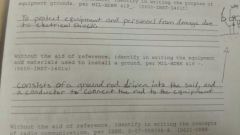
consists of a ground rod driven into the soil, and a conductor to connect the rod to the equipment
|
|
|
The components of a tactical radio communication system
|
TRANSMITTER: the source of the information to be transferred. in conversation this would be the person talking.
RECEIVER: the intended destination of the information to be transferred. This would be the listener. POWER SUPPLY: devices that provide the voltage necessary to operate electronic equipment. ANTENNA: has a function in both the transmitting and receiving processes of a radio. RECEIVER/TRANSMITTER (R/T): most tactical radio communications systems in use today. single radio item that combines both receiver and transmitter. |
|
|
The concepts of radio communication
|
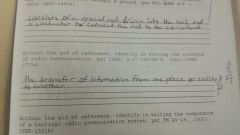
The transfer of information from one place or entity to another.
|
|
|
The terms associated with radio fundamentals.
|
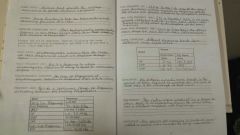
RADIO FREQUENCY (RF): this is a frequency in which electromagnetic radiation of energy is useful for communications purposes.
ELECTROMAGNETIC SPECTRUM: the range of frequencies of electromagnetic radiation as measured from 0 Hz to infinity RADIO WAVES: electromagnetic waves within the range of radio frequencies which are broadcast through space. FREQUENCY BAND: this is a continuous range of frequencies extending between two limiting frequencies. HIGH FREQUENCY (HF): (3.0-30 MHz) the range of the ground wave decreases with an increase in frequency and the sky waves are greatly influenced by ionospheric conditions. VERY HIGH FREQUENCY (UHF): (300-3,000 MHz) the direct wave must be used for all radio transmissions. RANGE COMPARISON: different frequency bands have different range capabilities WAVELENGTH: the distance a radio wave travels in the period of time required to complete one full cycle of that wave is the wavelength of that wave. CARRIERWAVE: the radio wave produced by a transmitter when there is no modulating signal, the carrier wave has a constant amplitude and frequency. MODULATION: the process of changing a constant signal called a carrier wave in order to carry information. AMPLITUDE MODULATION: this is the process in which the amplitude of the carrier wave is varied above and below it's normal value in accordance with the intelligence of the signal being transmitted SIDE BANDS: the AM modulation process produces frequency bands on both sides of the carrier wave which contain the frequencies of the wave produced by the process of modulation. FADING: the phenomenon which occurs when a radio signal is received over a long distance path and a periodic decrease of received signal strength results. FREQUENCY MODULATION: this is the process of varying the frequency of the carrier wave in accordance with the variations of the modulating signals POLARIZATION: also called wave polarization, is an expression of the orientation of the lines of electric flux in an electromagnetic field with respect to the surface of earth. VERTICAL POLARIZATION: if the electric field lines of force are at right angles to the surface of the earth, the wave and the antenna are vertically polarized. OVER WATER: for transmission over large bodies of water, using a ordinary antenna at mast heights around 40 ft., vertical polarization is advantageous for frequencies less than about 100 MHz. AIRCRAFT INTERFERENCE: radiation using vertical polarization is less affected by reflections from aircraft flying over the transmission path. BROADCAST INTERFERENCE: with vertical polarization, less interference is produced or picked up because of strong VHF and UHF broadcast transmission and reception all of which use horizontal polarization. HORIZONTAL POLARIZATION: if the electric field lines of force are parallel to the surface of the earth, the wave and the antenna are horizontally polarized. BI-DIRECTIONAL: a simple horizontal half wave antenna is bi-directional. This characteristic can help minimize interference from certain directions. HEAVY FOLIAGE: when antennas are located near dense forest, horizontally polarized waves suffer lower losses than vertically polarized waves, especially above about 100 MHz. FLEXIBILITY: small changes in antenna location do not cause large variations in the field intensity of horizontally polarized waves when antennas are located among trees or buildings. PROPAGATION: the phenomenon by which any wave moves from one point to another; the travel of electromagnetic waves through space or along a transmission line. |
|
|
The factors affecting ground wave propagation.
|
radio transmissions that do not utilize waves that have been refracted from the ionosphere.
|
|
|
ground wave components
|
comprised of three distinctly diffrent components: the direct wave, the ground-reflected wave, and the surface wave.
|
|
|
surface wave
|
component of the ground wave that follows the curvature of the earth and is affected by the conductivity of the earth.
|
|
|
ground-reflected wave
|
component of the radiated wave that reaches the recieving antenna after being reflected from the surface of the earth.
|
|
|
direct wave
|
component of the entire ground wave front that travels directly from the transmitting antenna to the recieving antenna.
|
|
|
cancellation
|
Due to the different paths they travel the direct wave and the ground reflected wave may arrive at the received antenna out of phase with each other.
|
|
|
frequency characteristics of ground waves.
|
The frequency of a ground wave determines which wave component will prevail along way given signal path.
|
|
|
earth's surface conductivity
|

determines how much of the surface wave signal energy will be absorbed or lost.
|
|
|
The factors affecting sky wave propagation.
|
types of radio transmissions that depend on the ionosphere to provide signal paths between transmitter and receivers.
|
|
|
atmosphere
|
The propertise and the nature of the atmosphere through which radio waves must travel from the transmitting antenna to the receiving antenna.
|
|
|
troposphere
|
portion of the earth's atmosphere extending from the surface of the earth to a height of 6.8 miles
|
|
|
stratosphere
|
portion of the earth's atmosphere lying between the troposphere and the ionosphere, from 6.8 miles to 30 miles above the earth.
|
|
|
ionosphere
|
portion of the earth's atmosphere in which ionization of low pressure gases will affect the transmission of radio waves.
|
|
|
D-layer
|
exist only during daylight hours and has little affect in bending the path of high frequency radio waves.
|
|
|
E-layer
|
used during the day for high - frequency radio transmission over distances less than 1,500 miles
|
|
|
F-layer
|
exists at heights up yo 240 miles above the surface of the earth and is ionized at all hours of the day and night.
|
|
|
F1 and F2 layers
|
During the day, air warmed by sunlight causes the "F" region to split into two distinct layers, the "F1" layer and the "F2" layer.
|
|
|
ionospheric variations
|
The density of the ions which can affect HF communications.
|
|
|
regular variations
|
These are variations which we know will occur on a regular basis.
|
|
|
daily variations
|
occur daily and are caused by the rotation of the earth.
|
|
|
seasonal variations
|
caused by the annual variations in temp. on the earth's surface and the earth's elliptical orbit around the sun.
|
|
|
27 day
|
caused by the rotation of the sun on its axis every 27 days.
|
|
|
11 year
|
Our sun's radiation intensity level is constantly changing. researchers have determined that the Suns radiation levels vary from low to high and back to low every 11 years.
|
|
|
irregular variations
|
The transient or momentary ionospheric variations, through unpredicted, have important effects on radio propagation.
|
|
|
sudden ionospheric disturbance (SID)
|
Are ionization abnormalities of the "D" layer
|
|
|
sporadic E
|
consists of anomalies of the E layer
|
|
|
ionospheric storms
|
These storms may last from several hours to several days, and usually extend over the entire earth.
|
|
|
nuclear detonations
|
The physical properties of the ionosphere can also be greatly altered during a nuclear explosion.
|
|
|
sky wave modes
|
The area where the sky wave returns to the earth depends on the height of the ionized layer and the amount of bending the wave encounters while traversing the layer.
|
|
|
skip zone
|
The skip zone is that area where no usable signal can be received from a given transmitter operating at a given frequency.
|
|
|
skip distance
|
The distance between the points where the radio wave leaves the transmitting antenna and where a sky wave from that antenna returns to the earth's surface from the ionosphere.
|
|
|
The alpha-numeric designations for world time zones.
|

EAST LONGITUDE: A. number 1-12 B. lettered "A"-"M" C. letter "J" omitted many languages didn't use "J" D. designated minus (-) zone.
WEST LONGITUDE: A. numbered 1-12 B. lettered "N"-"Y" (in reversed order) C. designated plus (+) zone INTERNATIONAL DATE LINE: an imaginary line on the surface of the earth opposite of the prime meridian which offsets the date as one travels east or west across it. |
|
|
ordinal calender
non - leap year (left) leap - year (right) |

|
|
|
communication security
|
The protective measures taken to deny unauthorized persons information derived from telecommunications of the u.s.
|
|
|
comsec material
|
material used to protect u.s. government transmissions, communications, and the processing of classified or sensitive unclassified info. related to national security from unauthorized persons.
|
|
|
comsec equipment
|
equipment designed to provide security to telecommunications.
|
|
|
controlled cryptographic item (CCI)
|
a secured telecommunications or information handling equipment.
|
|
|
two - person integrity (TPI)
|
system of handling and storing of comsec material, designed to prevent single - person access to certain comsec material.
|
|
|
compromise
|
The disclosure of info. or data unauthorized person(s).
|
|
|
suppression
|
scheduled or unscheduled replacement of comsec material with a different edition.
|
|
|
comsec incident
|
Any uninvestigated or unevaluated occurrence that has the potential to jeopardize the security of comsec material or the secure transmission of classified or sensitive government info.
|
|
|
The levels of security classification
|
TOP SECRET: info which could reasonably be expected to cause "exceptionally grave damage" to national security, if compromised
SECRET: info. which could reasonably be expected to cause "serious damage" to national security, if compromised CONFIDENTIAL: info. which could reasonably be expected to cause "damage" to national security, if compromised UNCLASSIFIED: this is any material which contains no classified info. |
|
|
The requirements for access to communication security.
|
CLEARANCE: the first requirement is a security clearance equal to or higher than the classification of the comsec material involved.
ACCESS: the second requirement is access; or the permission, liberty, or the ability to enter or approach areas containing comsec material, or authorization to gain possession or knowledge of comsec material. NEED TO KNOW: the third requirement is a "need to know." comsec material must be restricted to properly cleared individuals whose official duties require access to the material. SECURITY BRIEFING: the fourth requirement is that all individuals granted access to comsec material be properly indoctrinated regarding the sensitivity of the material. |
|
|
The types of communication security (comsec) incident reports.
|
INITIAL REPORT: submit an initial report for each comsec incident. may be accepted as a final report.
AMPLIFYING REPORT: submit the amplifying report whenever significant new info. is discovered or is requested by the evaluating authority. FINAL REPORT: the final letter report is submitted only if specifically requested by the appropriate authority. INTERIM REPORT: if an initial report is required but submission must be delayed because local inquiries/ investigations are on going. |
|
|
The communication security (comsec) storage regulations.
|
TPI HANDLING AND STORAGE REGULATIONS: if material is deemed to require TPI, two authorized persons must be present and remain within sight of each other and the TPI material whenever it is accessed and handled.
COMSEC MATERIAL STORAGE: store top secret keying material in a GSA approved security container with two combo locks/ store keying material in a CMS vault/ confidential keying material in a file cabinet having a built-in three-position manipulation resistant dial-type combo lock. DESTRUCTION: two types of circumstances under which classified material will be destroyed 1. routine 2 . emergency ROUTINE DESTRUCTION: comsec material is extremely sensitive, and if compromised, potentially exposed to compromise all of the info. encrypted by it. EMERGENCY DESTRUCTION: the procedures employed when comsec material is in danger of falling under enemy control. |
|
|
maintenance
|
RESPONSIBILITY: there are two levels of responsibility for maintenance of comsec materials.
COMMAND: ensures that the proper measures are observed for storage, distribution, and destruction of comsec materials. PERSONAL: refers to operator supervisory personnel. |
|
|
The duties of net control
|
-ensures that the circuit discipline is maintained at all times.
-limited transmission to essential traffic only. -ensures that traffic sent on the net is moved as fast as humanly possible without confusion. -resolve disputes concerning the flow and handling or traffic. -monitor all traffic. -enforced procedures and initiate corrective action for procedural discrepancies. -responsible for opening/closing of the network. |
|
|
The definition of terms that are associated with radio procedures.
|
COMMUNICATIONS NETWORK: an organization of stations capable of direct communication on a common channel or frequency.
NET CONTROL STATION: a communications station designated to control traffic and enforce circuit discipline within a given net. TACTICAL RADIO NET: a functional radio net used by a commander for immediate and direct control of the fire and maneuver or movement of his subordinate units. PRO-WORD: a word or phrase limited to radio procedure used to facilitate communication by conveying info. in a condensed standard form. PRO-SIGN: one or more letters or characters, used when abbreviating is needed when logging pro-words. CALL SIGN: any combo of characters or pronouceble words which identifies a communication facility, a command, an authority, an activity, or unit. BREVITY CODE: a code which provides no security but which has as its sole purpose the shortening of messages rather than the concealment of their content. RADIO SILENCE: a condition in which all radio equipment capable of transmitting is temporarily unauthorized for use. |
|
|
The types of call signs.
|
INDIVIDUAL: a call sign which pertains to one particular station.
COLLECTIVE: a call sign which is given to a predetermined group of stations. NETWORK: a call sign which identifies all stations on a network. TACTICAL: a call sign which identifies a tactical command or tactical communication facility. |
|
|
The purpose of radio circuit log.
|
utilized to provide an accurate record of all transmission on a tactical radio network.
|
|
|
The purpose of the phonetic alphabet.
|

provides a standardized method of writing and speaking characters in order to avoid confusion and limit errors during the transmission of voice communications on a tactical radio network.
|
|
|
number equivalents
|

|
|
|
The meanings of prosigns
|

|
|
|
The rules for radio circuit discipline.
|
ALWAYS maintain radio watch.
1. radio discipline is a fundamental ingredient of voice procedure without which a radio net cannot function efficiently. 2.use correct voice procedure. 3.use only authorized frequencies. 4.answer calls in the correct order and without delay. 5.listen carefully before transmitting to ensure that the net is clear and, where possible allow for stations which cannot be heard. NEVER 1.violate radio silence. 2.compromised classified info. by unauthorized plain language disclosure. 3.make unnecessary or unduly long transmission. 4.engage in unofficial conversation or operators chat. 5 .identify an individual, ship or unit by name, or any other personal or individual sign. 6.speak faster than the station experiencing the worst reception conditions can be expected to receive, thus avoiding needless repition. 7.use profane language. |
|
|
The purpose of the tactical field message book.
|
Also known as the "yellow canary", the tactical field message book is used to record tactical messages in a standardized manner, and serves as an official record for all messages that are transmitted on a tactical radio net.
|
|
|
The purpose of transmitting a size, activity, location, unit, time, equipment (salute) report
|
to report enemy activity that has been identified.
L1 SIZE- describe the approximate size of the enemy unit. L2 ACTIVITY- described the activity of the enemy unit. L3 LOCATION- six to ten digit grid coordinates of the enemy unit. L4 UNIT- described any info. which might be utilized to identify the enemy unit. L5 TIME- the date time group (Zulu time) when the enemy unit was identified. L6 EQUIPMENT- described any equipment the enemy unit is using. |
|
|
The contents of the communications - electronics operating instructions (CEOI)
|
GENERAL COMMUNICATION INSTRUCTIONS: provides instructions for the operations taking place, who it is directed by, and contains specific details regarding C/E equipment and systems used during the operation.
NET INFORMATION: the CEOI will provide info. regarding which nets are to be used, who will use them and when they will be used. CALLSIGN ASSIGNMENTS: the CEOI will provide a chart with call sign assignments for a specific unit during a specific time. FREQUENCY ASSIGNMENTS: provides a list of primary and secondary frequencies to be used for each net during an exercise/ operation. CRYPTOGRAPHIC INFORMATION: provides info. regarding which editions of keying material are to be used, when they are to be used and time change info. about when they need to be discontinued. |
|
|
non - electronic communication
|
SIGNS/COUNTERSIGNS: the CEOI provide info. used for challenge and password procedures which can be used for authentication or when entering/exiting friendly lines.
PYROTECHNICS/SMOKE CODES: the CEOI provides info. regarding the use of pyrotechnics and smoke. DESTRUCTION: CEOI will provide the exact procedures on how and when the CEOI must be destroyed. |
|
|
The appropriate action for the given unit on a given tactical net.
|

1. find the desired unit, company, etc. (left hand side).
2. find the desired net type (across the top). 3. find the assigned duty code in the column for the TAR/HR net (c). 4. find the frequency, search the TAR/HR column. |
|
|
The purpose of the communications - electronics operating instructions. (CEOI)
|
contains technical guidance for the establishment of communications. it provides the details required to coordinate and control the various communications within a unit.
|
|
|
The definition of terms that are associated with electronic warefare.
|
ELECTRONIC WAREFARE: the military action involving the use of electromagnetic energy to determine, exploit, reduce or prevent the enemy the use of radio systems, and actions taken to retain the use of friendly radio systems.
ELECTROMAGNETIC INTERFERENCE: a pulse of intense electromagnetic radiation generated by certain physical events. |
|
|
The divisions of electronic warefare.
|
ELECTRONIC ATTACK (EA): the division of electronic warefare involving the actions taken to prevent or reduced the enemy's effective use of the electromagnetic spectrum and employment of weapons that use electromagnetic or directed energy.
JAMMING: the deliberate radiation or reflection of electromagnetic energy for the purpose of degrading or disrupting the enemy's effective use of electronic devices , equipment, and radio systems. SPOT JAMMING: the power of the jamming signal is concentrated on one frequency. BARRAGE JAMMING: the power of the jamming signal is spread over several frequencies simultaneously. SWEEP JAMMING: the power of the jamming signal is concentrated on one or a few frequencies at a time and is swept or moved over a large range of frequencies. DECEPTION: the deliberate transmission of signals intended to mislead the enemy in the usage of the info. received by his communications system. MANIPULATIVE DECEPTION: the falsification of info. on a friendly communications net in order to confuse or mislead any enemy units that may be listening. IMITATIVE DECEPTION: the breaking into enemy communications net in order to confuse or to convince enemy units to destroy other enemy units. OPERATOR ACTIONS: radio operators must be able to determined whether or not their radios are being jammed. JSIR REPORT: if the radio operator suspects jamming or enemy intrusion on the net, the radio operator suspects jamming or enemy intrusion on the net, the radio operator should report it immediately to his/her radio chief who will report it to your units s2. ELECTRONIC PROTECTION (EP): the division of electronic warefare involving the actions taken to protect friendly communications from enemy exploitation while ensuring unimpeded use of the electromagnetic spectrum, despite the enemy's use of electronic attack measures. ELECTRONIC WAREFARE SUPPORT (ES): the division of electronic warefare involving the actions taken to search for, intercept, identify, and locate sources of international or unintentional or unintentional radiated electromagnetic energy for the purpose of immediate threat recognition. INTERCEPTION: measures taken to identify frequencies used by the enemy and to record and analyze enemy transmissions on those frequencies in order to collet info. DIRECTION FINDING: measures taken to locate enemy radio sites, either visually or by the use of radio direction finding (DF) equipment RADIO DIRECTION FINDING: interception is only one of the many dangers that the radio operator will face. If the enemy knows opposing forces are in the area, the enemy will try to locate their position by using radio direction finding (RDF) equipment. |
|
|
The purpose of operator technical manuals.
|
to provide a description of equipment and illustrations of parts. Also provides instructions for preparation, operation, troubleshooting, lubrication, and maintenance of the equipment.
|
|
|
The terms associated with preventive maintenance checks and services.
|
daily: divided into 3 events - before, during, after operations
weekly: same process as daily but more detailed. monthly: same process as weekly but in greater depth. |
|
|
The documents used to record preventive maintenance actions.
|
EQUIPMENT RECORD JACKET: required for all end items of equipment maintained by the owning unit and are normally kept at the shop using the equipment.
SL-3 INVENTORY/ SL-3/ SL-EXTRACT: to provide a technical description, a list of all required components and accessories, and an inventory sheet for a given item. LIMITED TECHNICAL INSPECTION (LTI): used to record the initial inspection an item goes through upon first being accepted into a unit. PREVENTIVE MAINTENANCE CHECKS AND SERVICES (PMCS)RECORD- used to record that scheduled PMS |

